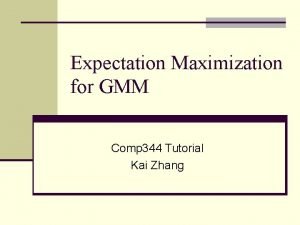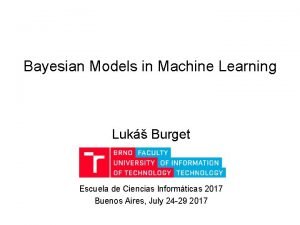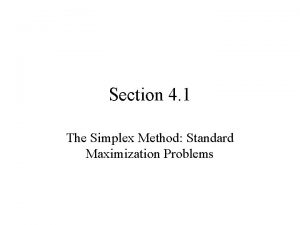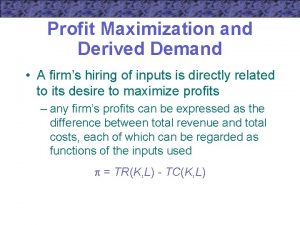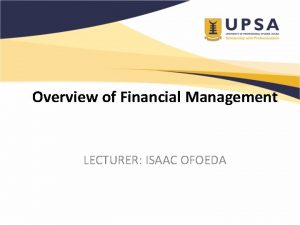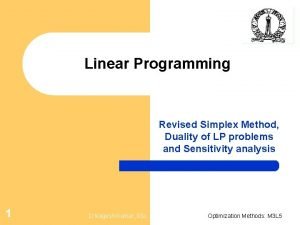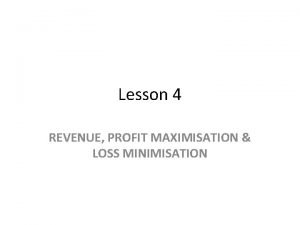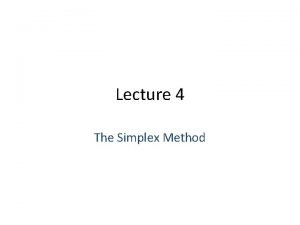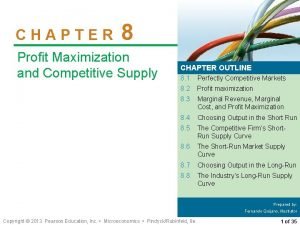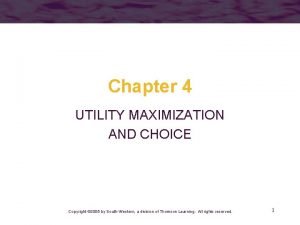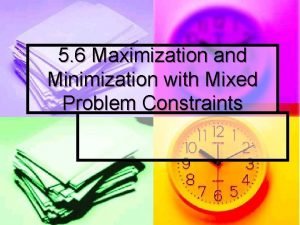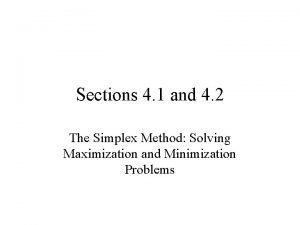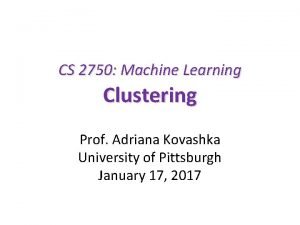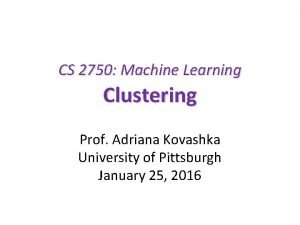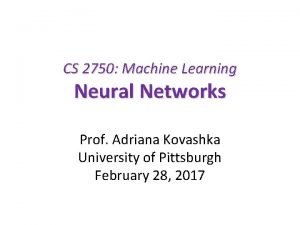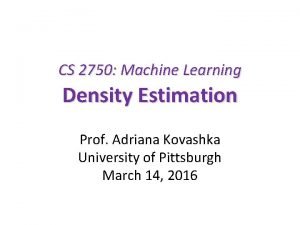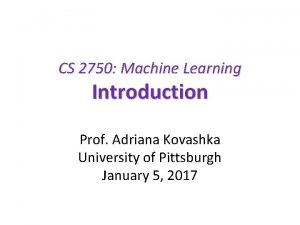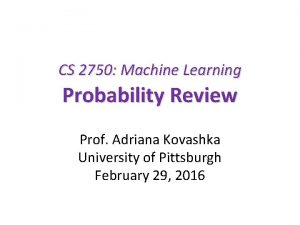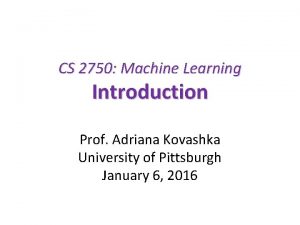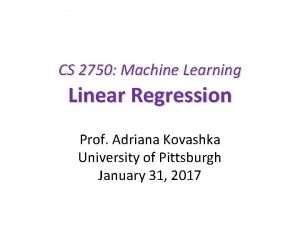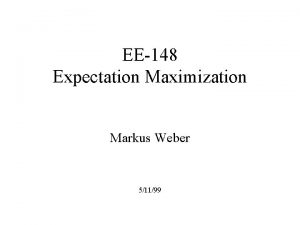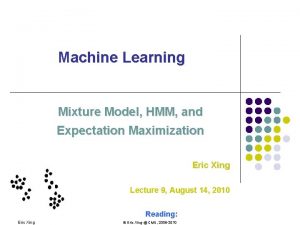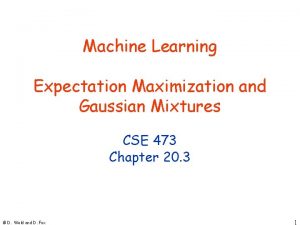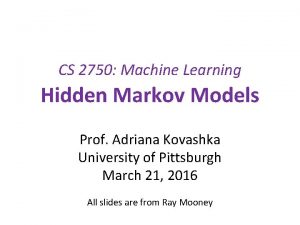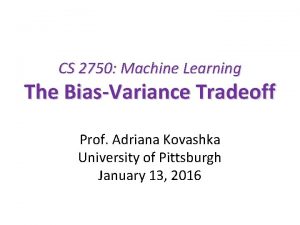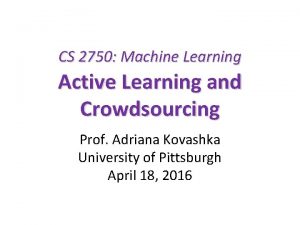CS 2750 Machine Learning Expectation Maximization Prof Adriana




























- Slides: 28

CS 2750: Machine Learning Expectation Maximization Prof. Adriana Kovashka University of Pittsburgh April 11, 2017

Plan for this lecture • • • EM for Hidden Markov Models (last lecture) EM for Gaussian Mixture Models EM in general K-means ~ GMM EM for Naïve Bayes

The Gaussian Distribution Chris Bishop

Mixtures of Gaussians Old Faithful data set Single Gaussian Chris Bishop Mixture of two Gaussians

Mixtures of Gaussians Combine simple models into a complex model: Component Mixing coefficient K=3 Chris Bishop

Mixtures of Gaussians • Introducing latent variables z, one for each x • 1 -of-K representation: • Also: • Then p(x) = Σz p(x, z) = Σz p(z) p(x|z) = Figures from Chris Bishop

Mixtures of Gaussians • Responsibility of component k for explaining x: Figures from Chris Bishop

Generating samples • Sample a value z* from p(z) then sample a value for x from p(x|z*) • Color generated samples using z* (left) • Color samples using responsibilities (right) Figures from Chris Bishop

Finding parameters of mixture • Want to maximize: • Set derivative with respect to means to 0: Figures from Chris Bishop

Finding parameters of mixture • Set derivative wrt covariances to 0: • Set derivative wrt mixing coefficients to 0: Figures from Chris Bishop

Reminder • Responsibilities: • So parameters of GMM depend on responsibilities and vice versa… • What can we do? Figures from Chris Bishop

Reminder: K-means clustering Basic idea: randomly initialize the k cluster centers, and iterate: 1. Randomly initialize the cluster centers, c 1, . . . , c K 2. Given cluster centers , determine points in each cluster For each point p, find the closest ci. Put p into cluster i 3. Given points in each cluster , solve for ci Set ci to be the mean of points in cluster i 4. If ci have changed, repeat Step 2 Steve Seitz

Iterative algorithm Figures from Chris Bishop

Figures from Chris Bishop

Initialization Figures from Chris Bishop E step M step

EM in general • For models with hidden variables, the probability of the data X = {xn} depends on the hidden variables Z = {zn} • Complete data set { X, Z} • Incomplete data set (observed) X, have • We want to maximize: Figures from Chris Bishop

EM in general • We don’t know the values for the hidden variables Z • We also don’t know the model parameters θ • Set one, infer the other • Keep model parameters θ fixed, infer the hidden variables Z (compute conditional probability) • Keep Z fixed, infer the model parameters θ (maximize expectation)

EM in general Figures from Chris Bishop

GMM in the context of general EM • Complete data log likelihood: • Expectation of this likelihood: • • Choose initial values μold, Σold, πold, evaluate responsibilities γ(znk) Fix responsibilities, maximize expectation wrt μ, Σ, π Figures from Chris Bishop

K-means ~ GMM • Consider GMM where all components have covariance matrix εI (I = the identity matrix): • Responsibilities are then: • As ε 0, most responsibilities 0, except γ(znj) 1 for whichever j has the smallest Figures from Chris Bishop

K-means ~ GMM • Expectation of the complete-data log likelihood, which we want to maximize: • Recall in K-means we wanted to minimize : where rnk = 1 if instance n belongs to cluster k, 0 otherwise Figures from Chris Bishop

Example: EM for Naïve Bayes • We have a graphical model: flavor shape color P(round, brown) 0. 282 P(round, red) 0. 139 P(square, brown) 0. 141 P(square, red) 0. 438 Total candies 1000 Log likelihood P( X|Θ) = 282*log(0. 282) + … = -1827. 17 • Flavor = class (hidden) • Shape + color = features (observed) Example from Rebecca Hwa

Example: EM for Naïve Bayes • Model parameters = conditional probability table, initialize it randomly Example from Rebecca Hwa P(straw) P(choc) P(round|straw) P(square|straw) P(brown|straw) P(red|straw) P(round|choc) P(square|choc) P(brown|choc) P(red|choc) 0. 59 0. 41 0. 96 0. 04 0. 08 0. 92 0. 66 0. 34 0. 72 0. 28

Example: EM for Naïve Bayes • Expectation step • Keeping model (CPT) fixed, estimate values for joint probability distribution by multiplying P(flavor) * P(shape|flavor) * P(color|flavor) • Then use these to compute conditional probability of the hidden variable flavor: P(straw|shape, color) = P(straw, shape, color) / P(shape, color ) = P(straw, shape, color) / Σflavor P(flavor, shape, color) Example from Rebecca Hwa

Example: EM for Naïve Bayes • Expectation step p(straw, round, brown) p(straw, square, brown) p(straw, round, red) p(straw, square, red) p(choc, round, brown) p(choc, square, brown) p(choc, round, red) p(choc, square, red) P(round, brown) P(round, red) P(square, brown) P(square, red) Example from Rebecca Hwa 0. 05 0. 00 0. 52 0. 02 0. 19 0. 10 0. 08 0. 04 0. 24 0. 60 0. 10 0. 06 p(straw | round, brown) p(straw | square, brown) p(straw | round, red) p(straw | square, red) p(choc | round, brown) p(choc | square, brown) p(choc | round, red) p(choc | square, red) 0. 19 0. 02 0. 87 0. 36 0. 81 0. 98 0. 13 0. 64 Log likelihood P( X|Θ) = 282*log(0. 24) + … = -2912. 63

Example: EM for Naïve Bayes • Maximization step • Expected # “strawberry, round, brown” candies = P(strawberry | round, brown) // from E step * # (round, brown) = 0. 19 * 282 = 53. 6 • Can find other expected counts needed for CPT Example from Rebecca Hwa

Example: EM for Naïve Bayes • Maximization step exp # straw, round exp. # straw, square exp # straw, red exp # straw, brown exp # straw exp # choc, round exp # choc, square exp # choc, red exp # choc, brown exp # choc Example from Rebecca Hwa 174. 56 159. 16 277. 91 55. 81 333. 72 246. 44 419. 84 299. 09 367. 19 666. 28 P(straw) P(choc) P(round|straw) P(square|straw) P(brown|straw) P(red|straw) P(round|choc) P(square|choc) P(brown|choc) P(red|choc) 0. 33 0. 67 0. 52 0. 48 0. 17 0. 83 0. 37 0. 63 0. 55 0. 45

Example: EM for Naïve Bayes • Maximization step • Compute with new parameters (CPT) • • P(round, brown) P(round, red) P(square, brown) P(square, red) • Compute likelihood P(X|Θ) • Repeat until convergence Example from Rebecca Hwa
 Expectation maximization tutorial
Expectation maximization tutorial Expectation maximization algorithm
Expectation maximization algorithm 2750 + 1500
2750 + 1500 Asme 2750 furnace
Asme 2750 furnace Concept learning task in machine learning
Concept learning task in machine learning Analytical learning in machine learning
Analytical learning in machine learning Pac learning model in machine learning
Pac learning model in machine learning Pac learning model in machine learning
Pac learning model in machine learning Inductive and analytical learning
Inductive and analytical learning Inductive and analytical learning problem
Inductive and analytical learning problem Instance based learning in machine learning
Instance based learning in machine learning Inductive learning machine learning
Inductive learning machine learning First order rule learning in machine learning
First order rule learning in machine learning Eager learner vs lazy learner
Eager learner vs lazy learner Cmu machine learning
Cmu machine learning Cuadro comparativo de e-learning b-learning y m-learning
Cuadro comparativo de e-learning b-learning y m-learning Standard maximization problem
Standard maximization problem Monopsony profit maximization
Monopsony profit maximization Limitations of profit maximization
Limitations of profit maximization Dual simplex method maximization example
Dual simplex method maximization example Profit maximizing output
Profit maximizing output Slack constraint
Slack constraint Normal profit vs economic profit
Normal profit vs economic profit Profit maximization and competitive supply
Profit maximization and competitive supply Lesson 3 cost revenue and profit maximization
Lesson 3 cost revenue and profit maximization Marshallian demand function
Marshallian demand function Quasi linear utility function
Quasi linear utility function Big m method minimization with mixed constraints
Big m method minimization with mixed constraints Simplex method maximization calculator
Simplex method maximization calculator
